Jupiter Spins So Fast That There Is a New Sunrise Nearly Every 10 Hours Clip Art
How to start right using a new telescope — a guide to basics you lot demand to know, how to ready it up, and what y'all can notice in the night sky.
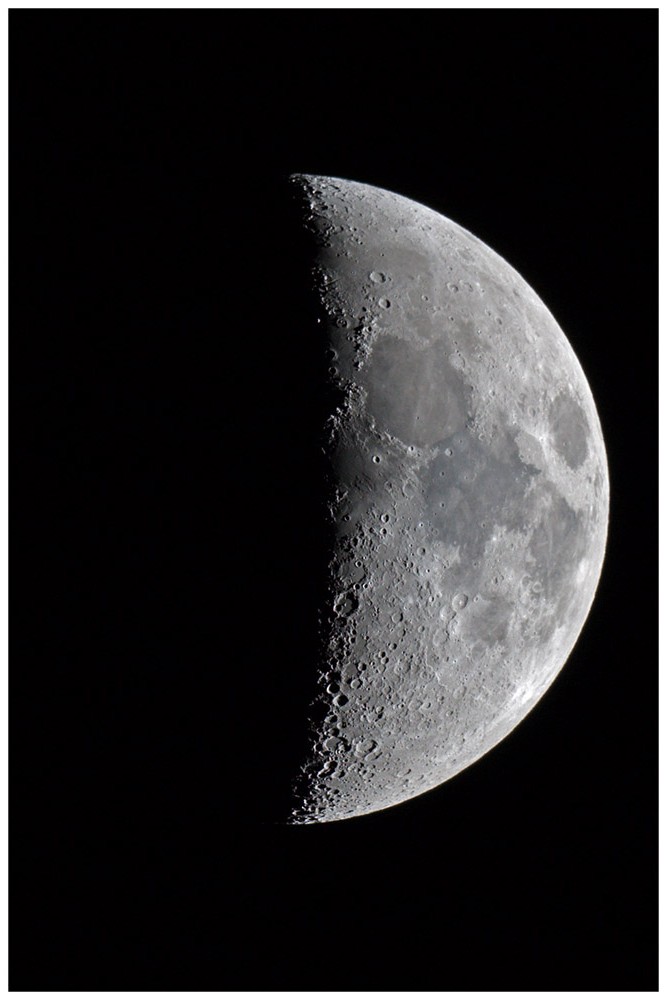
Gary Seronik
Perhaps you but got a shiny new telescope to call your ain. Congratulations — you lot could exist on your mode to making lifelong friends with stupendous, faraway things in your night sky. However, nearly of them are and then far and faint that only finding and positively identifying them is the claiming — and the accomplishment! Whether your new scope is a long, sleek tube or a meaty curiosity of computerized wizardry, surely you're itching to try it out.
Earlier Yous Observe
Here are 3 crucial tips for starting on the right foot, to avoid frustrations and move chop-chop up the learning bend.
Showtime, go your scope all fix up indoors. Read the instructions, and get to know how it all works — how information technology moves, how to alter eyepieces, and then on — in warmth and comfort. That manner you don't have to figure out unfamiliar knobs, settings, and adjustments outside in the common cold and dark.
Second, take the scope outside in the daytime and familiarize yourself with how information technology works on distant scenes — treetops, buildings — to get a good feel for what it really does. For instance, you lot'll quickly discover that a telescope's lowest magnification (the eyepiece with the longest focal length, meaning the one with the highest number on it) gives the brightest, sharpest, and widest views, with the least amount of the wiggles. The lowest power too makes information technology easiest to notice what yous're trying to aim at, thanks to that relatively wide field of view. Then you'll always desire to beginning off with the lowest power. Switch to a higher-magnification eyepiece only after you've institute your target, got it centered, and had a good, careful commencement wait.
Also: If the telescope has a trivial finderscope or a blood-red-dot pointing device fastened to its side, daytime is the easiest time to marshal the finder with the principal scope. You demand to do this. Aim the telescope at a afar treetop or other landmark, center it in the view, lock the mount'south motions if the mount allows this, recheck that the treetop is still centered, then look through the finderscope. Apply the finder'south adjustment screws to center the crosshairs (or crimson dot) on the same treetop. Then recheck over again that it'southward still in the center of the main scope's view, in instance you may take bumped it off in the procedure.
Tertiary , programme to be patient. Spend fourth dimension with each sky object you're able to locate, and really get to know information technology. As well many first-time telescope users expect Hubble-similar brightness and color in the eyepiece — when in fact most astronomical objects are very dim to the human center. Moreover, our night vision sees dim things more often than not as shades of greyness. Much of what the universe has to offering is subtle and, again, extremely far abroad!
But the longer and more carefully you examine something, the more of it you'll gradually discern. Astronomy teaches patience.
On the other manus, the Moon and the naked-eye planets are bright and easy to find! They make excellent first targets for new telescopic observers. Sky & Telescope's This Week's Sky at a Glance has suggestions for both telescopic and naked-center viewing of the brightest stars and planets.
Here are some suggestions for starting off.
New-Telescope Please: The Moon
The Moon is one celestial object that never fails to print in even the most humble scope. Information technology's our nearest neighbour in infinite — big, bright, starkly dour, and just a quarter one thousand thousand miles away. That's a hundred times closer than the nearest planet ever gets. An amateur telescope and a good Moon map can keep you busy forever.
Tonight (December 25, 2021) the Moon doesn't ascension into good view until after midnight, and it's highest and best earlier the kickoff calorie-free of dawn. Just by Jan fourth or 5th the Moon returns to the evening sky equally a crescent, growing thicker each night for the side by side calendar week and a half. On Jan 8th it volition be just about like the movie to a higher place (taken by an apprentice through a small telescope): nearly outset quarter (one-half lit), and loftier in the evening sky. Afterward that information technology thickens through its "bulgy" gibbous phase, as more and more than of the side facing World becomes sunlit.
The Moon volition become full on Jan 17th. But the when the Moon is full we see no shadows being bandage sideways to dramatize the mountains and craters. You'll always come across lunar surface features best forth the Moon'south terminator, the lunar sunrise or dusk line. Look over again at the photo at the elevation of this page. The terminator is where the low Sunday in the lunar sky casts long blackness shadows fifty-fifty from depression hills, mountains, and crater walls. The advancing terminator unveils new landscapes day by day when the Moon is waxing, then hides them in darkness 24-hour interval by day when the Moon is waning after full. In between at total Moon, the terminator lies all around the Moon's edge out of sight.
Bright Planets
As information technology happens, your new scope has arrived at a special fourth dimension for iii of the bright naked-middle planets. Jupiter, Saturn, and brilliant Venus polish in the southwest in twilight, in a long diagonal line from upper left to lower right in that social club.
Commencement early in bright twilight with Venus, considering it's about to set. (In fact it'south gone by twilight's end.) Right now Venus is going through its most dramatic phase: every bit a vivid, very thin crescent, unusually large. What you're seeing is the edge of Venus'south dayside. Its white cloud cover is dazzlingly lit by the Sun, which shines closer and brighter on Venus than information technology does on Earth. Picket day by day as the crescent thins further and the planet moves lower into the sunset glow. You'll probably lose sight of information technology in the first few days of January 2022.
Side by side, Jupiter! Information technology'due south the bright white "star" much college, far to Venus's upper left. In even the smallest telescope Jupiter'south four pointlike moons evidence lined upwards on either side of information technology. They modify configuration endlessly from night to night. Jupiter itself spins so fast (once every x hours) that it's not quite round, and even a minor telescope will reveal this. And can y'all make out whatsoever of Jupiter'due south parallel deject belts? They frequently darken or brighten, broaden or narrow, over a thing of months or years.
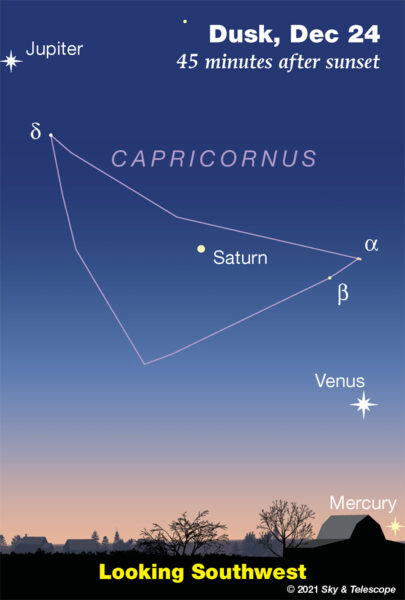
Between Venus and Jupiter is Saturn, much less brilliant. Aye, information technology has rings! Tin you run across the hairline blackness Cassini Sectionalisation between the inner B band and the narrower, outer A ring? And look for subtle deject belts on the globe of the planet itself.
The other two vivid planets? Mercury is very deep in the glow of sunset correct at present but will become a picayune higher, in better view, for the first half of January. Mercury is the smallest planet, farther from us than Venus and showing a dull gray surface, so you'll exist doing well just to come across its irresolute phase.
And Mars? It's very depression in the e at dawn, currently faint and far on the opposite side of its orbit from united states. It'southward and so small and far that in a telescope it will just be a fuzzy orange dot. Simply wait till a yr from now. In late autumn 2002 and early winter 2003 Mars volition be passing relatively close to Earth, inviting close examination for a few brief months. Did I say astronomy teaches patience?
More than New-Telescope Sights
There's much more to the night sky than the Moon and planets, of course. Wintertime nights ofttimes bring crisp, transparent skies with a chiliad canopy of stars. Simply with so many inviting targets overhead, where to betoken first?
Here's a proposition! The familiar constellation Orion climbs the southeastern sky in the evening these weeks. In its middle, await for the three-star line of Orion'due south Belt. The Belt is almost vertical as it rises in early evening. It turns diagonal (every bit shown in below) tardily at night.
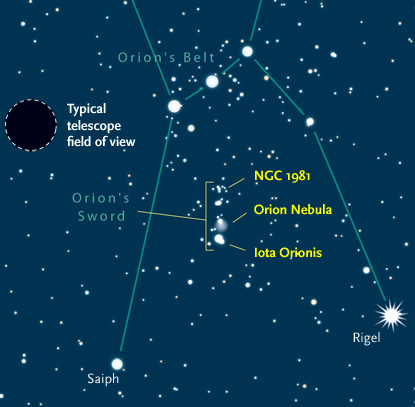
Sky & Telescope diagram
Just a few degrees southward of the Belt (that is, a few finger-widths at arm'due south length) runs a smaller, dimmer line of stars: Orion's Sword. Within it lies the Orion Nebula, a luminous cloud of gas and dust where new stars are forming by the hundreds. It shows pink in about photographs, but to the human middle it's dim gray with a hint of green. The nebula is evident in any telescope once you go pointed at it, and then is the tight quartet of immature stars near its center, known as the Trapezium. Astronomers refer to the Orion Nebula as Messier 42 (M42), and yous'll see it labeled that way on star charts. Located about 1,400 low-cal-years away, it'southward the closest massive star-forming nebula to Earth.
Dim objects similar nebulae are best seen when the sky is moonless and really dark. The farther you can go out from nether the skyglow of urban center light pollution, the better. But don't let lite pollution dissuade you from finding what you can run into from your own backyard! Choose reasonably brilliant targets to hunt, and develop the skills to find them and notice them carefully and so yous'll be ready to brand the most of better weather condition when the run a risk arises. For instance, the sky tin can be especially clean and dark the night after a storm passes through.
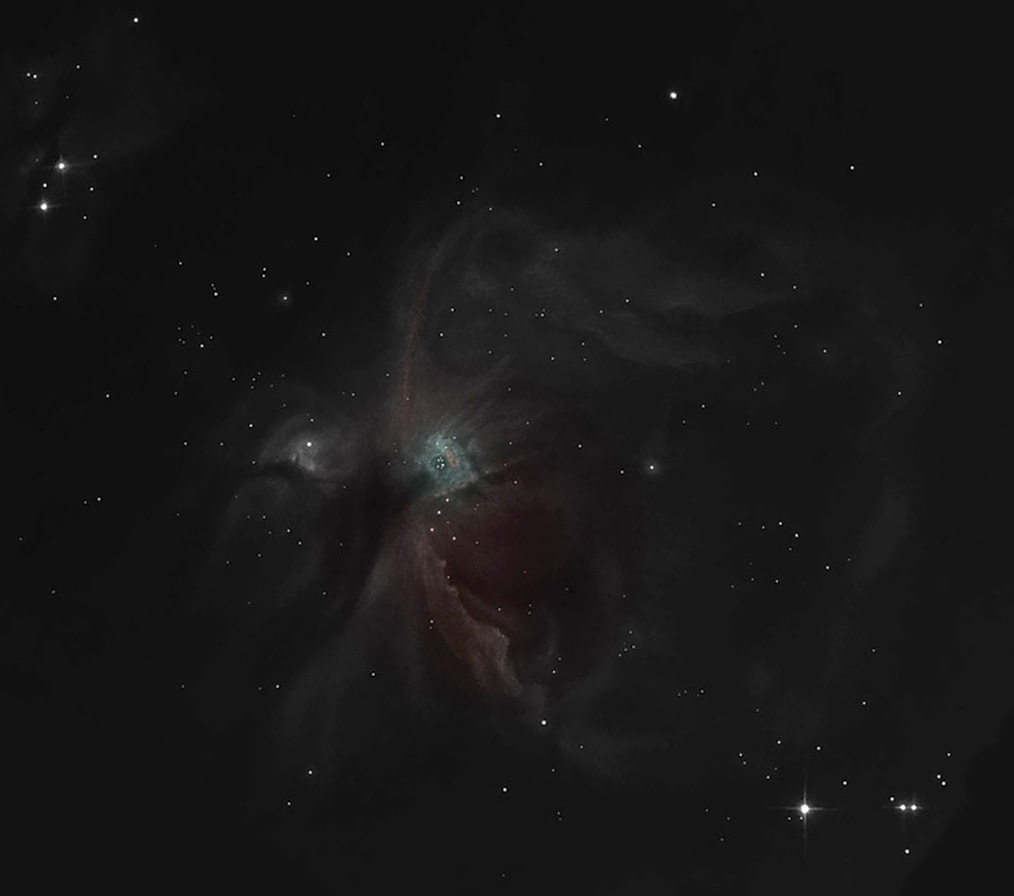
Howard Banich / South&T Online Gallery
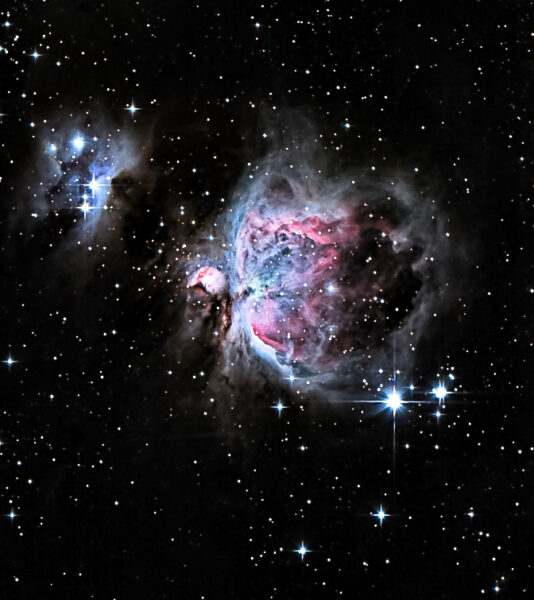
Joshua Rhoades / S&T Online Gallery
Yous tin use Orion'southward Belt equally a arrow to other things. Extend its line far upwardly across the sky, past most two fist-widths at arm'due south length, and at that place'southward the relatively vivid star Aldebaran, the orange eye of Taurus. Keep on by near another fist and you'll reach the little cluster of stars chosen the Pleiades. It'south about the size of your fingertip at arm's length.
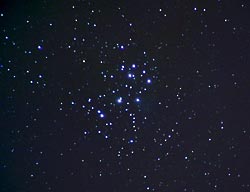
Through binoculars or a telescope at its everyman magnification, the Pleiades cluster shows dozens of stars. Astronomers have adamant that the cluster has near 500 in all. Similar other star clusters, the Pleiades are held together past their mutual gravity. This one is classed as an open cluster for the stars' relatively uncrowded organization. Information technology'due south nearby equally star clusters become, traveling through space as a swarm most 440 light-years away.
The Pleiades stars, astronomers have determined, began to shine only about seventy to 100 meg years ago. This makes them mere toddlers compared to our Sun and solar system, which are 4.half dozen billion years old. M45'southward youthful suns are astonishingly energetic. Alcyone (al-SIGH-oh-nee), the brightest, is at to the lowest degree 350 times as luminous every bit our Sun. Like the other vivid Pleiads it gleams with an intense blue-white light — a sign that it's unusually hot and massive.
Adjacent Steps in Astronomy
To find much else in the night sky, start learning the constellations. They're the key to locating everything fainter and deeper to hunt with binoculars or a telescope — only as you need to know the continents and countries on a earth of Earth before you can pinpoint, say, Milan or Sydney.
For an easy-to-apply constellation guide covering the whole evening sky, utilize the big monthly map in the middle of each issue of Sky & Telescope, the essential magazine of astronomy (ahem).

You'll too want a good, detailed star atlas (set of more detailed maps), such equally the widely used Pocket Sky Atlas ; a good deep-heaven guidebook; and some practice in how to utilise the maps to pinpoint the aim of your telescope onto a something also faint to encounter with your optics lone.
For more than tips on skywatching and how to get the nigh out of your scope, encounter our Observing section and Getting Started section.
Any else, stick with it! Nobody is born knowing this stuff. Work your mode into the hobby at your ain stride, finding things to know and practise and understand without worrying nearly everything you lot don't yet. That'south really what life in a big universe is all most.
Source: https://skyandtelescope.org/astronomy-news/getting-started-with-your-new-telescope/
0 Response to "Jupiter Spins So Fast That There Is a New Sunrise Nearly Every 10 Hours Clip Art"
Post a Comment